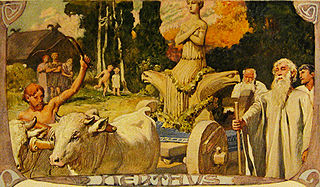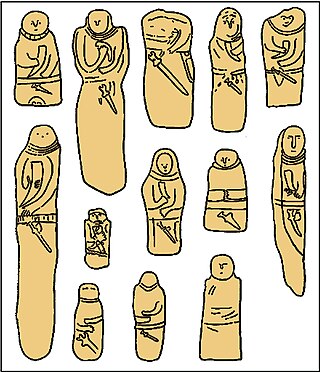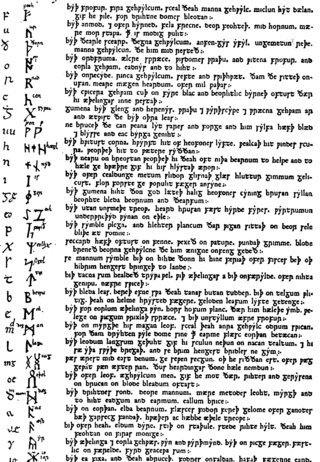
Ares is the Greek god of war and courage. He is one of the Twelve Olympians, and the son of Zeus and Hera. The Greeks were ambivalent towards him. He embodies the physical valor necessary for success in war but can also personify sheer brutality and bloodlust, in contrast to his sister, the armored Athena, whose martial functions include military strategy and generalship. An association with Ares endows places, objects, and other deities with a savage, dangerous, or militarized quality.

Týr is a god in Germanic mythology, a valorous and powerful member of the Æsir and patron of warriors and mythological heroes. In Norse mythology, which provides most of the surviving narratives about gods among the Germanic peoples, Týr sacrifices his hand to the monstrous wolf Fenrir, who bites it off when he realizes the gods have bound him. Týr is foretold of being consumed by the similarly monstrous dog Garmr during the events of Ragnarök.

Æsir or ēse are gods in Germanic paganism. In Old Nordic religion and mythology, the precise meaning of the term "Æsir" is debated, with it being able to refer to both the gods in general or specifically to one of the main families of gods, in contrast to the Vanir, with whom they waged war, ultimately leading to a joining of the families. The term can further be used to describe local gods that were believed to live in specific features in the landscape such as fells. In the Old English Wið færstice, the Ēse are referred to, along with elves, as harmful beings that could cause a stabbing pain, although exactly how they were conceived of by the author of the text is unclear.

Tuesday is the day of the week between Monday and Wednesday. According to international standard ISO 8601, Monday is the first day of the week; thus, Tuesday is the second day of the week. According to many traditional calendars, however, Sunday is the first day of the week, so Tuesday is the third day of the week. In some Muslim countries, Saturday is the first day of the week and thus Tuesday is the fourth day of the week.

Thor is a prominent god in Germanic paganism. In Norse mythology, he is a hammer-wielding god associated with lightning, thunder, storms, sacred groves and trees, strength, the protection of humankind, hallowing, and fertility. Besides Old Norse Þórr, the deity occurs in Old English as Þunor ("Thunor"), in Old Frisian as Thuner, in Old Saxon as Thunar, and in Old High German as Donar, all ultimately stemming from the Proto-Germanic theonym *Þun(a)raz, meaning 'Thunder'.

Germanic mythology consists of the body of myths native to the Germanic peoples, including Norse mythology, Anglo-Saxon mythology, and Continental Germanic mythology. It was a key element of Germanic paganism.

An Irminsul was a sacred, pillar-like object attested as playing an important role in the Germanic paganism of the Saxons. Medieval sources describe how an Irminsul was destroyed by Charlemagne during the Saxon Wars. A church was erected on its place in 783 and blessed by Pope Leo III. Sacred trees and sacred groves were widely venerated by the Germanic peoples, and the oldest chronicle describing an Irminsul refers to it as a tree trunk erected in the open air.

Interpretatio graeca, or "interpretation by means of Greek [models]", refers to the tendency of the ancient Greeks to identify foreign deities with their own gods. It is a discourse used to interpret or attempt to understand the mythology and religion of other cultures; a comparative methodology using ancient Greek religious concepts and practices, deities, and myths, equivalencies, and shared characteristics.
In Germanic mythology, Seaxnēat or Saxnōt was the national god of the Saxons.
Interpretatio germanica is the practice by the Germanic peoples of identifying Roman gods with the names of Germanic deities. According to Rudolf Simek, this occurred around the 1st century AD, when both cultures came into closer contact.
The t-rune ᛏ is named after Týr, and was identified with this god. The reconstructed Proto-Germanic name is *Tîwaz or *Teiwaz. Tiwaz rune was an ideographic symbol for a spear.

Ares is a fictional character, a deity appearing in American comic books published by Marvel Comics. The character is based on the Greek god of the same name. He first appeared in Thor #129 and was created by Stan Lee and Jack Kirby. Ares has commonly appeared as an enemy of Thor and Hercules and starred in his own self-titled series in 2006.

Ares is a character appearing in DC Comics publications and related media. Based on the eponymous Greek mythological figure, he is the Olympian god of war and major recurring adversary of the superhero Wonder Woman. He has been featured significantly as a persistent foe throughout every era of Wonder Woman's comic book adventures, and in many adaptations of her stories in other media.

The Scythian religion refers to the mythology, ritual practices and beliefs of the Scythian cultures, a collection of closely related ancient Iranic peoples who inhabited Central Asia and the Pontic–Caspian steppe in Eastern Europe throughout Classical Antiquity, spoke the Scythian language, and which included the Scythians proper, the Cimmerians, the Sarmatians, the Alans, the Sindi, the Massagetae and the Saka.
"For a Swarm of Bees" is an Anglo-Saxon metrical charm that was intended for use in keeping honey bees from swarming. The text was discovered by John Mitchell Kemble in the 19th century. The charm is named for its opening words, "wiþ ymbe", meaning "against a swarm of bees".
Ares has appeared frequently in modern popular culture; he usually appears as the ancient Greek god of war in the most generally familiar classical mythology.

The characters of the God of War video game franchise belong to a fictional universe based on Greek mythology and Norse mythology. As such, the series features a range of traditional figures, including those from Greek mythology, such as the Olympian Gods, Titans, and Greek heroes, and those from Norse mythology, including the Æsir and Vanir gods and other beings. A number of original characters have also been created to supplement storylines.

The Seax of Beagnoth is a 10th-century Anglo-Saxon seax. It was found in the inland estuary of the Thames in 1857, and is now at the British Museum in London. It is a prestige weapon, decorated with elaborate patterns of inlaid copper, brass and silver wire. On one side of the blade is the only known complete inscription of the twenty-eight letter Anglo-Saxon runic alphabet, as well as the name "Beagnoth" in runic letters. It is thought that the runic alphabet had a magical function, and that the name Beagnoth is that of either the owner of the weapon or the smith who forged it. Although many Anglo-Saxon and Viking swords and knives have inscriptions in the Latin alphabet on their blades, or have runic inscriptions on the hilt or scabbard, the Seax of Beagnoth is one of only a handful of finds with a runic inscription on its blade.

The Old English rune poem, dated to the 8th or 9th century, has stanzas on 29 Anglo-Saxon runes. It stands alongside younger rune poems from Scandinavia, which record the names of the 16 Younger Futhark runes.













